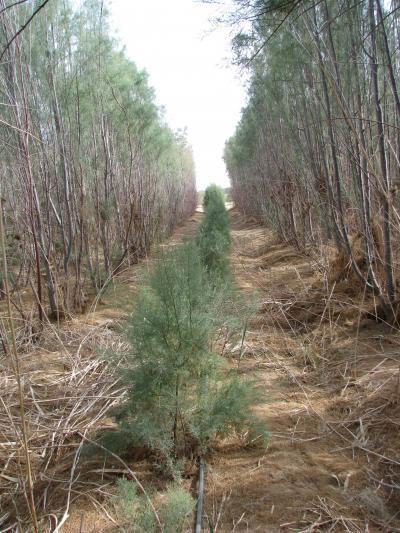Planting forests in the Avarah desert
Researchers work at Tel Aviv University, Israel, conducting plantations in the Aravah desert, Israel.
By planting native plants, (using recycled wastewater that is not suitable for agriculture) in arid lands in the Aravah, Israel, researchers include Professor Amram Eshel and Professor Aviah Zilberstein, working at the New Renewable Energy Center and Life Science Center George S. Wise, Department of Molecular Biology and Plant Ecology, Tel Aviv University, Israel, has succeeded in contributing to reducing atmospheric carbon emissions.
In many parts of the world, including areas in India, Central Asia and the Sahara desert region, the planting of native plants in difficult, dry, terrain conditions actually gives effect. fruit in an effort to reduce CO 2 emissions. Plants that can absorb carbon dioxide from the atmosphere and convert it into oxygen.

The results of this research study were published in the European Journal of Plant Science and Biotechnology.
Although our current plantation is a necessary initiative, Professor Eshel said, this is not enough to offset global CO2 emissions. In an effort to plant new forests, in order to reduce atmospheric CO2, many countries have converted fertile agricultural land into forests. However, researchers believe that encouraging growth (forest area) on a dry land, such as desert land, is a more feasible trend.
"When you look at the overall carbon balance of converting farmland and fresh water into energy products, you may not get much benefit," said Eshel.
"Because you invested a lot of energy in this transition, thus contributing to the release of a large amount of CO2 into the atmosphere."
To conserve fresh water, researchers used water sources considered to be of low quality, such as recycled wastewater and salt water as a product of a domestic desalination plant. The final stage is to find a native plant that is well adapted to the desert environment. The researchers chose Tamarix (a plant genus that includes salt cedar and native species living in deserts). About 150 different types of plants are used, developed in both settings: a popular garden and commercial plant density simulation.
Besides, desert forest trees (not using agricultural land) can also be used as a renewable energy source. "Biomass" or "biofuels" , derived from natural plants, may help reduce dependence on traditional fossil fuels such as coal.
"It is necessary to deploy desertification on a global scale, such as the Sahara desert, large enough to grow crops on a larger scale." Professor Eshel added: "what has been done in the Aravah desert, Israel, can be replicated in other places (other deserts) to bring great effect in compensating for emissions. CO2 into the atmosphere today ".
This study is a collaboration between Porter School of Environmental Science, Tel Aviv University, Israel; University of Tuscia, in Viterbo, Italy; and Hebrew University, in Jerusalem, Israel. Research funding is provided by the Ministry of Environment, Land, and Sea, Italy.
- Planting forests on ... desert
- Green Walls will save China from sandstorms?
- Israel's advanced irrigation method has turned arid desert into a place to grow vegetables and fish
- Planting trees by helicopter
- Scientific reports instructing how many trees to plant are enough to save the Earth
- The most exotic deserts in the world
- Planting forests on coal mines
- The largest desert - desert in the world (1)
- Technical planting and care of Thai porcelain
- Project to turn desert into ... forest
- Amazon forests are at risk of turning into desert
- Binh Thuan: Need to replicate the model of anti-sand planting forest
 Is the magnetic North Pole shift dangerous to humanity?
Is the magnetic North Pole shift dangerous to humanity? Washington legalizes the recycling of human bodies into fertilizer
Washington legalizes the recycling of human bodies into fertilizer Lightning stone - the mysterious guest
Lightning stone - the mysterious guest Stunned by the mysterious sunset, strange appearance
Stunned by the mysterious sunset, strange appearance